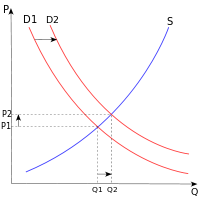Most authors (including me) are not experts in economics. Many of them might have a vague idea that if their book was priced high, they’d make more money. But this ignores the relationship between price and quantity sold. The author should be seeking to maximize income over all, not income per book sold.
Caveat: I’m no economist, so this is my best guess at the economics of e-book pricing. The thousands of economists who read my blog should comment and correct any errors I make.
 The relationship between price and quantity, from the consumer’s (or reader’s) view, is what economists call the demand curve. Price something high and few people will buy it, and vice versa. In classic economic theory, the demand curve gets paired with a supply curve and the intersection of the curves yields the equilibrium price. The theory behind the supply curve is that high prices compel suppliers to produce more, and vice versa.
The relationship between price and quantity, from the consumer’s (or reader’s) view, is what economists call the demand curve. Price something high and few people will buy it, and vice versa. In classic economic theory, the demand curve gets paired with a supply curve and the intersection of the curves yields the equilibrium price. The theory behind the supply curve is that high prices compel suppliers to produce more, and vice versa.
How does this apply to your electronic book? The demand curve indicates you’ll sell more books at a lower price and fewer at a higher price.
But you can throw the supply curve out the window when it comes to e-books. Why? The supply curve is based on some assumptions, which are true for most products:
1. If you’ve produced x items so far, there is some measureable effort expended and resources used to produce the x + 1 item.
2. Since resources are needed to produce the x + 1 item, it is possible to have shortages or surpluses of the item.
3. The market is competitive.
None of those assumptions is true for e-books. After the first book is produced, there is zero effort and zero resources expended for all the books that follow. Therefore there can be no shortages or surpluses. Also, the market is not competitive; there is only one source for your book. Whoever publishes it has exclusive rights, though they may license competitive distributors to get the book to readers.
So it’s impossible to draw a supply curve for an e-book. Quantity is irrelevant, so no supply curve, and no equilibrium price.
If you’re an author wondering whether your e-book is priced right, the lack of a supply curve and equilibrium price doesn’t leave you any more lost than you would be otherwise, though. That’s because those curves represent a reasonable theory of how most markets work. In practice, things get difficult.
Here’s a thought experiment: Say you want to plot the demand curve for your just-published e-book using real data. You set the price at $10,000 and nobody buys it. You gradually lower the price each week and plot the sales data. Eventually your book is priced at $0.01, demand is very high, and you’ve got your complete curve drawn.
The problems are: (1) many decades have elapsed, and (2) you haven’t ended up with the real demand curve after all, but pieces of many curves. That’s because the curve changes with time too. Economists say demand curves shift right or left depending on consumer tastes and preferences, the prices of related goods, and other factors which change with time. What you really wanted at the launch of your e-book was the complete curve at that time, but there’s no practical way to determine it.
Sadly, e-book pricing involves guesswork. If you’re self-publishing, you can set the price near that of similar books, and alter that price as circumstances warrant. If you engaged a publisher, you have to trust their guesswork.
They call economics the dismal science, and we’ve arrived at a dismal conclusion. Don’t blame me. I’m no economist; I’m—
Poseidon’s Scribe
